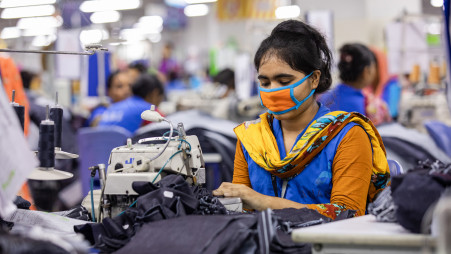Staff Correspondent
Published:2020-12-03 20:08:23 BdST
APAC region's largest wage fall recorded in Bangladesh
The real minimum wages in Bangladesh witnessed the largest fall in Asia and the Pacific (APAC) region in the last decade while Vietnam recorded highest growth, according to a latest report of the International Labour Organization (ILO).
Bangladesh is also the only country in the region whose average annual minimum wages did not reach even the lowest international poverty line and entirely set by the industry, it revealed.
"Between 2010 and 2019, the largest decreases in real minimum wages were observed in Bangladesh and Sri Lanka," according to the report published on Wednesday.
The report titled 'Global Wage Report 2020-21: Wages and minimum wages in the time of COVID-19' revealed that Bangladesh's real minimum wages witnessed 5.9 per cent negative growth against its 5.8 per cent annualised labour productivity growth during the decade.
The rate is 4.5 per cent and 4.0 per cent respectively for Sri Lanka.
When asked, labour secretary K M Abdus Salam said there is a permanent minimum wage board to review the minimum monthly wages of all the industrial sectors in every five years.
The board maintains a tripartite mechanism to fix the minimum wages for workers, he noted.
"Wages of workers are being increased gradually. Now the RMG workers are not low paid," he said.
Along with the RMG sector, minimum wages of many other industrial sectors increased significantly in recent times, he said.
Among the countries that have experienced an increase in real minimum wages, according to the report, the highest 11.3 per cent average annual increases were observed in Vietnam followed by 10.1 per cent in Lao People's Democratic Republic and 9.7 per cent in Cambodia.
The labour productivity growth was 5.1 per cent, 5.6 per cent and 5.5 per cent respectively in these three countries.
The average annual growth of real minimum wages in China was 6.0 per cent against its 6.8 per cent growth in labour productivity.
India recorded 3.9 per cent growth in real minimum wages against its 5.5 per cent labour productivity growth while in Pakistan it was 3.5 per cent and 2.2 per cent respectively, according to the report.
The real minimum wages increased in 22 countries and decreased in eight countries during the period under review.
The median value of the monthly minimum wages is US$ 381 (purchasing power parity-PPP), with values ranging from US$ 48 (PPP) in Bangladesh to US$ 2,166 (PPP) in Australia.
The report, however, noted that the higher rates were applied in Bangladesh's garment sector.
Results showed that the minimum wages are set, on average, at around 55 per cent of the median wage in developed countries and at 67 per cent of the median wage in developing and emerging economies.
In developing and emerging economies, minimum-to-median wage ratios range from 16 per cent in Bangladesh to 147 per cent in Honduras.
Globally, the median value of gross minimum wages for 2019 is equal to US$ 486 PPP per month, meaning that half of the countries in the world have minimum wages set lower than this amount and half have minimum wages set higher. Some countries have minimum wages below the poverty line.
"Sufficiently frequent adjustment is crucial to maintain minimum wages at an adequate level, and a very low level often reflects failure to adjust rates regularly over time."
In practice, only 54 per cent of countries with statutory minimum wages adjusted their minimum wages at least every two years during the period 2010-19. Of all the countries, only two - Angola and Bangladesh - had already planned not to review minimum wage levels in 2020.
Angola undertakes a minimum wage adjustment every two years in March, and made an increase in 2019.
Bangladesh, which revises the minimum wage every five years, last did so in December 2018, the report said.
As of 2020, around 18 per cent of countries (29 countries) with statutory minimum wages exclude agricultural workers, domestic workers or both categories from minimum wage regulations.
Of these, seven countries including Bangladesh exclude both agricultural and domestic workers, the report added.
The report also found that monthly wages fell or grew more slowly in the first six months of 2020, as a result of the Covid-19 pandemic in two-thirds of countries for which official data was available, and that the crisis is likely to inflict massive downward pressure on wages in the near future.
The wages of women and low-paid workers have been disproportionately affected by the crisis. The report suggested a number of policy measures that can help implement minimum wages effectively and human-centred recovery from COVID-19 in the world of work.
"Appropriate and time-bound wage policies will play an important role in achieving this goal," the report said.
Unauthorized use or reproduction of The Finance Today content for commercial purposes is strictly prohibited.


